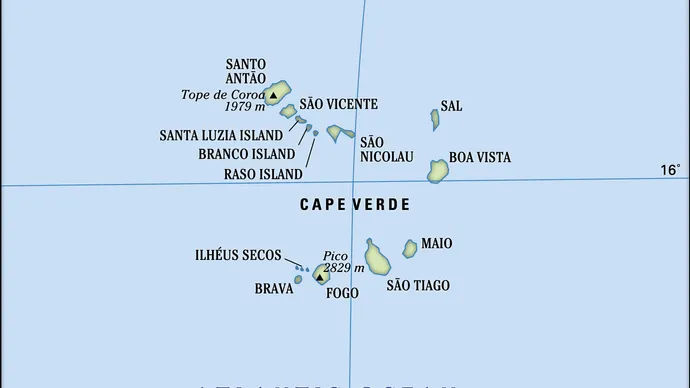[Cape Verde] Loggerhead Turtle - location stamp

Cape Verde is home to loggerhead turtles, and has one of the three largest nesting populations of these lovely, gentle animals. The turtles make their nests in the sand dunes on several of the Cape Verde islands. Most notably on the islands of Maio, Sal, Santiago and Boa Vista. These are the more easterly islands in the archipelago and furthermore the sandiest, which is why the turtles favour them.
The female turtle will normally come onto the beach between three and five times and at intervals of between 10 and 15 days. She will build her nest and lay her eggs and as many as 100 every time. The eggs will then hatch in approximately 60 days. The baby turtles then make their way into the sea, however, some sadly don’t survive.
Turtles mainly nest between July and October. To see the turtles hatch and make their way to the sea you will need to be there in August/September and maybe October. It is possible to arrange organised tours of the nesting grounds and also the hatcheries. Money raised in this way helps to fund the specialist conservation work. Sadly people hunt these gentle animals for food, furthermore the eggs are at risk of being stolen. In addition, they have to contend with the building of large tourist resorts. This removes sand from the beaches and introduces lighting, which confuses the turtles.

The Cape Verdeans take the protection and conservation of the turtles seriously. There are several projects set up to conserve these animals and also to maintain and preserve their nesting sites. In 2017, the Cape Verde government made it illegal to kill turtles.
In 2007 on the island of Sal, two people, Juan Blanco and Jacquie Cozens became very concerned about the welfare of turtles. They started patrolling the beaches and counting the nests, and also set up a hatchery project. These two people met and SOS Tartarugas was formed. More recently Projeto Biodiversidade was formed by some employees of SOS Tartarugas and the work has now been taken over by the new organisation.
On the island of Boa Vista The Turtle Foundation patrol the beaches where the turtles nest. This started in 2008 when the Foundation sent representatives to the Porto Ferreira beach. That is one of the main nesting beaches on the island. Before this, in 2007 some 600 or more turtles were slaughtered on that one beach. In 2008 the number had drastically reduced to 60. Now they are working on five beaches and the number of turtles being slaughtered has continued to reduce.
Whilst the islands of Sal and Boa Vista are probably best known for turtles, turtles also nest on other islands, such as Maio. On Maio, the work of protection is overseen by the Maio Biodiversity Foundation.
I think small turtles crawling towards the water might be a good idea for a stamp and it won't look like an Ecuador stamp and international turtle day
Log In
Shaiapufu
Stunning ✨
Bajaja
What a good idea. I especially like your design idea with a group of turtles. Btw. did you all know that a group of turtles is called "a bale"?
Itzae
This one is lovely, the research is most interesting, and I especially like the idea of little turtles crawling toward the sea. I personally would like if the art is similar to the Axolotl from México, the turtle from Ecuador, and the Kiwi from NZ :)
Yann2
Which is a nice one.
Please keep on it and if you have another Cabo Verde idea, a separate post is not a problem at all. Nice map and info, thank you!
mapuo
Itzae: another turtles https://feedback.slowly.app/stamp-requests/p/congo-the-conkouati-douli-national-park
Yann2
Thank you, - a lovely post!
Well researched and representative of Cabo Verde. I think it would be good to show a map and a bit of History as I imagine many people might not be familiar with the island's location and roots.
I am a great fan of Maritime History, and got to admit this will educate me as well, as I have not read much about it so far.
Cabo Verde
"Cape Verde or Cabo Verde, officially the Republic of Cabo Verde, is an archipelago and island country in the central Atlantic Ocean, consisting of ten volcanic islands with a combined land area of about 4,033 square kilometres (1,557 sq mi). These islands lie between 600 and 850 kilometres (320 and 460 nautical miles) west of Cap-Vert, the westernmost point of continental Africa. The Cape Verde islands form part of the Macaronesia ecoregion, along with the Azores, the Canary Islands, Madeira, and the Savage Isles.

The Cape Verde archipelago was uninhabited until the 15th century, when Portuguese explorers discovered and colonized the islands, thus establishing the first European settlement in the tropics. Because the Cape Verde islands were located in a convenient location to play a role in the Atlantic slave trade, Cape Verde became economically prosperous during the 16th and 17th centuries, attracting merchants, privateers, and pirates. It declined economically in the 19th century due to the suppression of the Atlantic slave trade, and many of its inhabitants emigrated during that period. However, Cape Verde gradually recovered economically by becoming an important commercial center and useful stopover point along major shipping routes. In 1951, Cape Verde was incorporated as an overseas department of Portugal, but its inhabitants continued to campaign for independence, which they achieved in 1975.
Since the early 1990s, Cape Verde has been a stable representative democracy, and has remained one of the most developed and democratic countries in Africa."
source: Wikipedia
see also : Britannica which has excellent, detailed maps.

Again, my sincere thank you for helping those lesser known countries gain some exposure and possibly the representation they deserve in the Slowly stamps collection. Cheers, friend! ✨😎👍🌞
Yann2
Thank you - I am heading there to read and learn some more. Cheers!